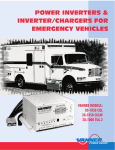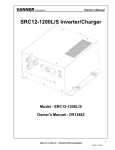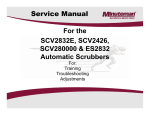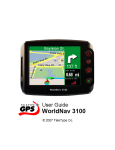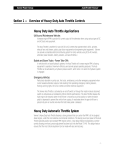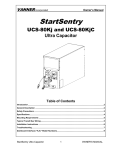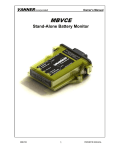Download Vanner 20-1000TUL Owner`s manual
Transcript
OWNER'S MANUAL Model 20-1000TUL—AC Power Inverter System OM/A96751 REV. A 20-1000TUL INVERTER—OWNER'S MANUAL Vanner Power Group Table of Contents Section 1— Introduction .................................................................................... 1 Section 2— Installing the 20-1000TUL ............................................................. 4 Section 3— Installing the IFM1 Interface Module ............................................. 6 Section 4— Installing the Inverter Remote Status Display Panel ........................ 7 Section 5— Inverter Status Panel Operation ....................................................... 8 Section 6— Operating the 20-1000TUL Inverter .............................................. 9 Section 7— Troubleshooting ............................................................................. 10 Section 8 — GFCI Test Record ........................................................................ 11 Warranty ........................................................................................................... 12 List of Figures Figure 1— System Diagram ................................................................................ 2 Figure 2— IFM1 Module Remote Wiring .......................................................... 7 Icon Legend Note Warning VANNER POWER GROUP 4282 Reynolds Drive • Hilliard, Ohio 43026 Tel (614) 771-2718 • Fax (614) 771-4904 1-800-AC POWER 20-1000TUL—OWNERS MANUAL © Copyright 1996, Vanner Weldon, Inc. OM/A96751 REV. A 20-1000TUL INVERTER—OWNER'S MANUAL Vanner Power Group Section 1: Introduction Thank you for purchasing a Vanner 20-1000TUL Power Inverter for your emergency vehicle. We are confident you will be satisfied with its performance. Vanner products are designed and manufactured by skilled professionals using the highest standards in workmanship, guaranteeing excellent performance and reliability for your emergency vehicle. With minimum maintenance and care, you can expect years of trouble-free service from your Vanner product. The 20-1000TUL is a 12 VDC to 120 VAC inverter with a transfer relay and Ground Fault Circuit Interrupter (GFCI) protected AC output. This unit is equipped with an AC line cord for AC input power (shore/utility power) and a receptacle with a GFCI for AC output. This enables you to plug AC loads directly into the inverter. The DC cables have quick connectors to facilitate installation and pre-wiring of emergency vehicles. Vanner 20-1000TUL Inverter —1— 20-1000TUL INVERTER—OWNER'S MANUAL Vanner Power Group Functionality Inverter WARNING Battery input cables must be connected to the battery with proper polarity to avoid damaging the inverter. The 20-1000TUL converts battery power to 1050 Watts of 120 VAC modified sine wave power to operate vital emergency vehicle equipment. The unit is easily connected to the positive and negative posts of a battery system with appropriate fusing, and when turned ON, produces 120 VAC True RMS power. The inverter also has an energy-saving feature called Load Demand. With this feature, the inverter output is pulsed, significantly reducing the current draw from the battery until a demand is made on its output. Continuous output of 120 VAC resumes when a load greater than 5 Watts is applied. The load demand feature can be disabled with the Setup Switch on the front panel. A built-in transfer relay senses AC input to the emergency vehicle (shore/utility power) and connects the AC input directly to the GFCI receptacle. At that time, all equipment which was operating on the inverter is now powered by the AC shore line. FIGURE 1—SYSTEM DIAGRAM —2— Vanner Power Group 20-1000TUL INVERTER—OWNER'S MANUAL Specifications Inverter 20-1000TUL Output at 120 VAC RMS (Continuous Power Rating) 1050 Watts Surge Capacity at 120 VAC (3 sec) 2100 Watts Input Voltage, VDC (Deep Cycle Battery Recommended) Output Voltage 12 VDC, Nominal 10.5 VDC min., 16.0 VDC max. 120 VAC ± 5% DC Current Draw (Batter y) (Battery) OFF 0.017 Amps Typical Load Demand (waiting)* 0.09 Amps Typical Full ON at No Load 0.7 Amps Typical Full ON with Load Approx. AC Load Watts ÷ 10 or AC Load Amps x 12 Frequency Output Wave Form 60 Hz ± 0.1% Modified Sine Wave Bypass TTransfer ransfer Output Current, GFCI Outlet 12 Amps Other Specifications Ambient Temperature Cooling Air Chassis Dimensions Weight -20o to +110oF, -29o to +43.4oC Fan Cooled, 30 cfm Aluminum 11.57”W x 5.94”H x 11.04”D 22 lbs * Determined by Setup Switch on front panel Remote Panel—D06638 & D06639 Remote Panel—D06638 & D06639 —3— 20-1000TUL INVERTER—OWNER'S MANUAL Vanner Power Group Section 2: Installing the 20-1000TUL Unpacking the Inverter ` NOTE Air enters by the fan at the rear of the unit, and exits through the sides of the unit. For maximum unit performance, avoid recirculating the same hot air through the unit. Inspect the shipping container and equipment for loose or damaged parts. If any damage is found, immediately notify the freight carrier. Installing the Inverter Step 1: Turn the inverter OFF/disconnect power to the wiring harness. Make sure power to the vehicle wiring harness is disconnected. Verify that the inverter is turned OFF by checking that the ON-OFF/RESET Inverter Switch is in the OFF-RESET position. (The button should NOT be pushed in.) Step 2: Select a location for the unit. An ideal installation location has the following characteristics: • Close to the battery (within six feet using #2 AWG wire) • Protected from the weather • Well ventilated DC Cable Length Size Maximum 2AWG 12ft. 1/O AWG 20 ft. Step 3: Route DC input cables. Route the negative and positive DC input cables from the inverter (through the quick connector) to the battery. If required, protect cables where they contact hard, sharp edges. Step 4: Install in-line fuse. Install an in-line Bussman ANN 125 or equivalent fuse (Vanner p/n 03640fuse and 03637-fuse holder) in the red, positive DC input cable between the battery and inverter, within 18 in. of the battery or DC wiring bus system. WARNING Battery input cables must be connected to the battery with proper polarity to avoid damaging the inverter. —4— Step 5: Connect Bonding Lug. Use a AWG #8 or larger copper conductor to connect the chassis bonding lug to the vehicle chassis and/or earth ground. Step 6: Connect the inverter to the battery. Connect the black, negative DC input cable from the quick connector to the battery negative (-) terminal. This battery negative terminal is usually where the battery negative connects to the engine block or frame. Connect the red, positive DC input cable from the quick connector to the fuse of the battery positive (+) terminal. This battery terminal is usually connected to the DC electrical system at the load side of the Battery Disconnect Switch. 20-1000TUL INVERTER—OWNER'S MANUAL Vanner Power Group Step 7: Select Load Demand option. Select Load Demand option, if desired, using the proper switch position on the front panel Setup Switch. With Load demand ON, the inverter conserves battery energy and operates only when a load greater than 5 Watts is applied. Step 8: Connect the AC loads. Connect the AC loads to the inverter GFCI receptacle. Any time AC power is applied to the AC input (shore/utility power), it will pass through this GFCI receptacle. Step 9: Verify installation. Verify all connections are tight and secure for maximum performance. Inverter LED Displays Inverter Battery Low Overtemp Overload Light Action Description Steady Green Light Inverter is On and operating. Single Blink Green Light Inverter circuit is Off. Shore power is On and supplying AC power to the AC loads. The inverter will turn On and supply the load if shore power is lost. Double Blink Green Light Inverter circuit is Off. Shore power is Off. The inverter is waiting for a load greater than 5 watts to be turned on. Light Description Action Solid Red Inverter is On and the battery is almost too low to operate the inverter. Blinking Red The inverter is Off. The battery voltage dropped below 10.5 volts DC and the inverter shut itself Off. Once shut off, the batteries must be recharged. Then, the inverter On/Off switch must be cycled to reset the unit. Light Description Action Solid Red The unit is Off. The unit has turned itself Off because the power MOSFET's are operating too hot. This can be caused by operating an AC load which is too large for the inverter, or lack of ventilation. When the unit cools the inverter will start operating again. Light Description Action Blinking Red The inverter is On but it is overloaded. Reduce the AC load quickly or the inverter will shut off due to the overload condition. Solid Red The inverter is Off. An overload has occurred and the inverter has shut off to protect itself. Once shut off, the inverter On/Off switch must be cycled to reset the unit. —5— 20-1000TUL INVERTER—OWNER'S MANUAL Vanner Power Group Section 3: Installing the IFM1 Interface Module This section describes the installation of the optional Vanner Model IFM1 Interface Module. Refer to the information provided in the IFM1 Interface Module Owner’s Manual for more information on installing the inverter and interface module in a vehicle rewired or retrofitted for the 20-1000TUL. If you are installing a new 20-1000TUL unit, you will need the interface module only if you are using the inverter status panel (p/n D06638), Remote Switch (p/n D06781), or if you require the inverter lockout feature. Installing the IFM1 Interface Module Step 1: Mount the Interface Module. Mount the interface module in the vehicle’s existing 12 V electrical system wiring harness with #8 screws. Select a physical orientation best suited for your application environment; however, it must be within the 2ft Interface Cable length to the inverter. Additionally, the unit should not be installed with pin connections facing upward. Step 2: Connect the Inverter to the Interface Module. Install the 2 ft. interface cable by plugging it into the remote RJ-11 connector on the 20-1000TUL and the J1 connector on the IFM1 Interface Module. Step 3: Connect the Battery Disconnect Switch. Connect the +12 V lead from the Module Disconnect Switch circuit to the inverter lockout Pin 1 (ignition switch or battery disconnect switch). The +12 V lead from the Battery Disconnect Switch must be fused with an in-line fuse or circuit breaker of 2 Amps or less. See Figure 2. Step 4: Wire the Remote Switch (p/n D06781) to Pins 2 through 5. Red to Pin 2, Black to Pin 3, Green to Pins 4 and 5. If no remote switch is used, two jumpers must be installed. The first jumper connects Pin 2 to Pin 3, the second jumper connects Pin 4 to Pin 5. See Figure 2. Step 5: Connect the Inverter Remote Status Display Panel (Optional). Connect the gray, green, and red wires from the inverter panel, through the OEM harness, to the IFM1 Module, Pins 6 (grey), 7 (green), and 8 (red). —6— 20-1000TUL INVERTER—OWNER'S MANUAL Vanner Power Group Section 4: Installing the Inverter Remote Status Display Panel The Inverter Remote Status Display Panel (p/n D06638) contains separate, red and green LED indicators. The green indicator light signifies the inverter is On or in Standby mode. The red, Fault LED indicator shows problems such as over temperature, output overload, or low battery. The panel has a sealed overlay which mounts easily on a flat surface. A 12-in. pigtail harness is included for easy installation. Use the following procedure to install the Inverter Remote Status Display Panel. Step 1: Select a location for the panel. Identify the desired location for the inverter panel. Step 2: Identify wires for installation. Identify the gray, green, and red wires on the inverter panel and vehicle's electrical system wires that will connect to the IFM1 Interface Module. Step 3: Splice and arrange wires. Splice together like-colored wires from the vehicle's electrical system to the status panel using an insulated butt splice or equivalent. Carefully arrange the wires such that the panel mounts flush against the surface to which it is mounted. Step 4: Secure panels to surface. Mount the panels using #8 screws through the four holes in the panel. FIGURE 2— IFM1 MODULE REMOTE WIRING —7— 20-1000TUL INVERTER—OWNER'S MANUAL Vanner Power Group Section 5: Inverter Status Panel Operation Two LEDs on the front of the Remote Status Display Panel indicate the status of the inverter. The status indicated by the LED displays is directly related to the status indicated by the LEDs on the front of the inverter. Inverter LED Inverter FFault ault LED Light Action Description Steady Green Light Inverter is operational. Single Blink-Green Light Inverter is not being used. Shore power is applied to load. Inverter will activate when shore power is unavailable. Double Blink-Green Light Inverter is on in the Load Demand mode and is waiting for AC load to be turned ON. Light Action Description Red Light Unit shutdown* — Check the inverter's front panel LEDs for reason of shutdown: Low Battery, Overload, or Overtemp. *Refer to the Troubleshooting section of this manual for fault diagnostic information. Section 6: Operating the 20-1000TUL Inverter —8— Vanner Power Group 20-1000TUL INVERTER—OWNER'S MANUAL Use the following instructions to operate the 20-1000TUL Inverter. Step 1: Install the 20-1000TUL unit. Completely install the inverter and charger using the instructions provided in Section 2 of this manual. NOTE Throughout this manual, shore/ utility power is referred to as AC input power. Step 2: Apply an AC load. Apply an AC load with AC input power present. The AC load is run directly from AC input power. The ON-OFF/RESET Inverter Switch does not affect the inverter's AC output when shore power is present. Step 3: Turn on the inverter Remote Switch. Step 4: Apply shore power to the 20-1000TUL/Ambulance shore line connection. Push the ON-OFF/RESET Inverter Switch to the ON position. When powered by the AC power, the ON lamp flashes, indicating that the inverter is standing by. Step 5: Verify Power. Apply an AC load, such as a shop light or drill. The AC load is run directly from AC input power. Step 6: Observe the inverter operation. Remove the shore line connection from the emergency vehicle. The unit will automatically switch to Inverter mode and operate the AC load using battery power. When shore power is restored, the unit examines the AC input for five seconds and then switches the loads back to run directly from AC input power. With the ON-OFF/RESET Switch in the ON position, a double flash of the ON light indicates the load demand is turned ON and the load is less than 5 Watts. —9— 20-1000TUL INVERTER—OWNER'S MANUAL Vanner Power Group Section 7: Troubleshooting the 20-1000TUL The following are the most common questions heard by Vanner service professionals. If your situation does not apply to the following categories, please contact your local Vanner Power Group Service Center. Vanner Power Group Customer Service: 1-800-AC-POWER SYMPT OM SYMPTOM The LEDs on the front panel blink in sequence. SOL UTION SOLUTION It is normal for this to occur if the inverter switch is On when the DC input is connected to the unit. If the DC is already connected and the LEDs blink in sequence then the DC input voltage is dropping. Check for poor connections in the DC wiring, bad battery or a heavy DC load. SYMPT OM SYMPTOM ON lamp does not light steadily after pushing in the ON-OFF/RESET Switch. SOL UTION SOLUTION Lamp flashes when utility power is present. Inverter Lamp flashes in Load Demand Waiting mode. Check/Reset GFCI on the receptacle. Check battery connections if utility power is OFF. Check DC fuses if utility power is OFF. SYMPT OM SYMPTOM ON lamp fully illuminates. AC load does not run. SOL UTION SOLUTION Check and reset circuit breaker. Verify AC load and cord are in proper condition. SYMPT OM SYMPTOM BATTERY LOW lamp illuminates when AC load is applied. SOL UTION SOLUTION Check battery connections. Check battery condition. Recharge battery if voltage is less than 10.5 VDC. Check AC loads for shorted circuit. Check the vehicle's alternator charging system for proper operation. — 10 — SYMPT OM SYMPTOM OVERTEMP lamp illuminates. SOL UTION SOLUTION Something has caused the unit to overheat. Check for obstruction of air flow to the cooling fan or from ventilation holes. Verify AC load is within unit’s rated capacity. SYMPT OM SYMPTOM OVERLOAD lamp illuminates with AC load applied. SOL UTION SOLUTION Verify AC load is within unit’s rated capacity. SYMPT OM SYMPTOM DC fuse blows when connecting DC input cables. SOL UTION SOLUTION Check for reverse polarity: red cable to battery positive (+), black cable to battery negative (-). The unit may be damaged and require repair service. 20-1000TUL INVERTER—OWNER'S MANUAL Vanner Power Group Section 8: GFCI Test Record For maximum protection against electrical shock hazard, operate the Test Switch on the Ground Fault Circuit Interrupter at least once a month. NOTE Photocopy this page and place it in your maintenance notebook. ENTER YEAR JAN FEB M A R APR M A Y J U N E J U LY AUG SEPT OCT NOV DEC 19____ — 11 — Limited Warranty 1. Vanner Weldon, Inc., referred to herein as Vanner, warrants that this product is free from defects in materials and workmanship for a period of one (1) year from its date of shipment from Vanner's factory. 2. This warranty does not cover defects caused by misuse, neglect, accident, reversed polarity, unauthorized repairs, and/or replacements. 3. All warranties of merchantability and fitness for a particular purpose; written or oral, express or implied, shall extend only for a period of one (1) year. There are no other warranties which extend beyond those described on the face of this warranty. 4. Vanner does not undertake responsibility to any purchaser of its product for any undertaking, representation, or warranty made by any dealers or distributors selling its products beyond herein expressed. 5. Vanner does not assume responsibility for incidental or consequential damages, including, but not limited to responsibility for loss of use of this product, loss of time, inconvenience, expense for telephone calls, shipping expense, loss or damage to property, or loss of revenue. 6. Vanner reserves the right to repair, replace, or allow credit for any material returned under this warranty. Any damage caused by the customer will be charged or deducted from the allowance. 7. All warranty work will be performed at Vanner's factory, or authorized repair facility. Products shall be delivered to Vanner's facility, freight prepaid. Products repaired under warranty, or replacement parts or products will be returned, F.O.B. Vanner factory. — 12 — Vanner PPower ower Group 4282 Reynolds Drive Hilliard, Ohio 43026 Tel (614) 771-2718 Fax (614) 771-4904 Specifications Subject to Change © Copyright 1996, Vanner Weldon Inc. Printed in the U.S.A. OM/A96751 REV. A 5/96
















